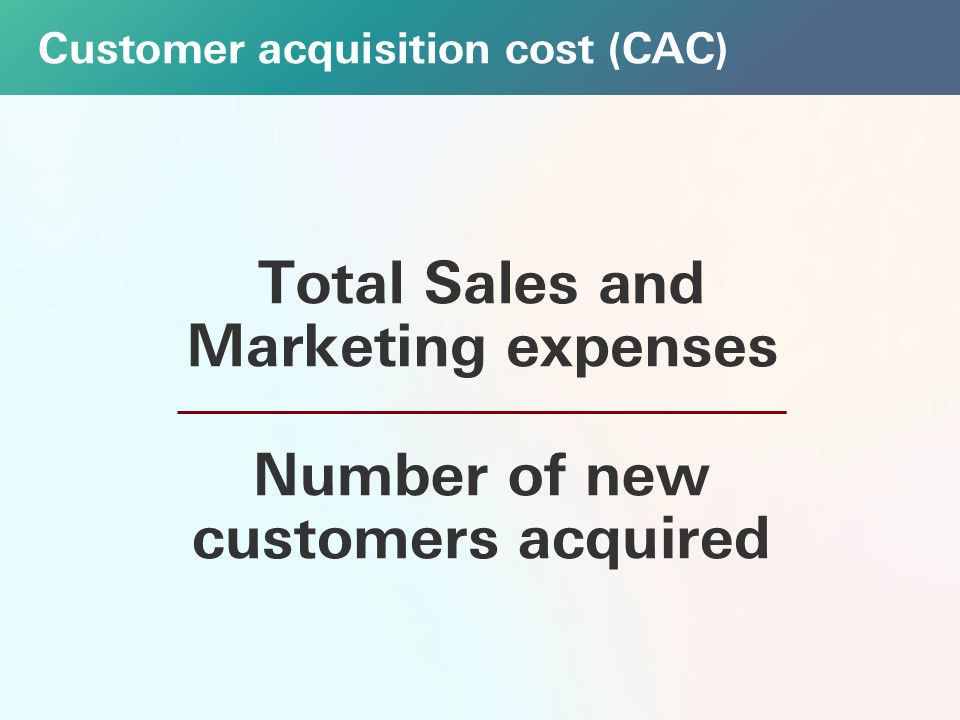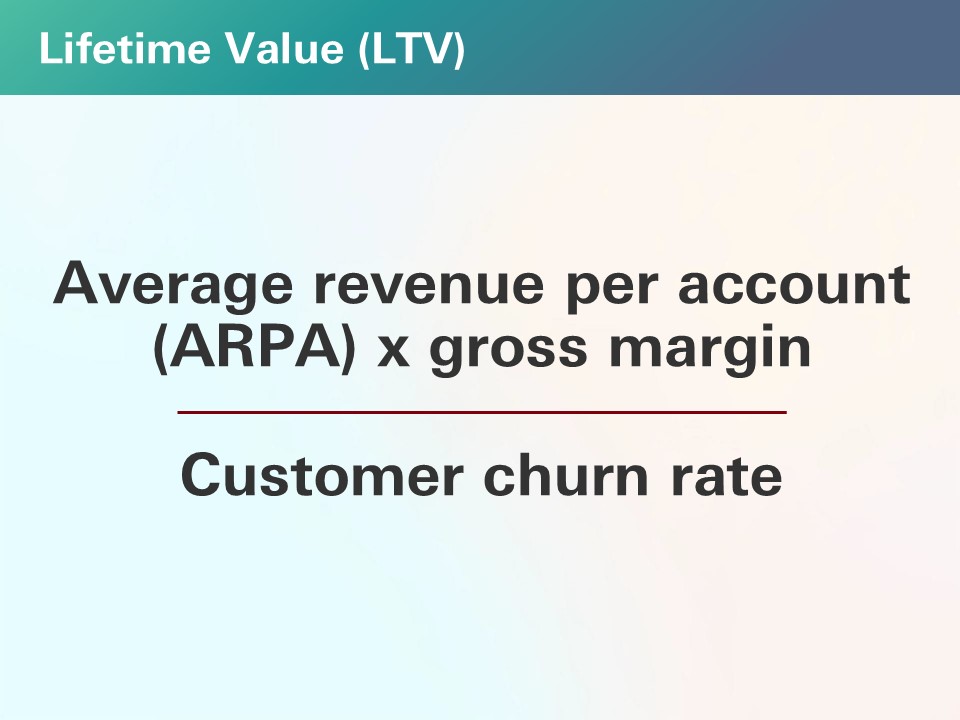Fundamentals of acquisition and retention: Part 1 - Customer acquisition
- Running a business
- Article
- 6 minutes read

Do you know how much it costs your company to sign a customer? Data collated by venture investor Meritech Capital suggests that sales and marketing spending in leading listed SaaS companies represents around 30% of revenue. That’s almost one in every three pounds you earn going to customer acquisition. So tracking and managing customer acquisition spend really matters.
In this article we’ll discuss ways to understand and control customer acquisition cost (CAC). This blog will be most helpful for B2B startup founders, especially those seeking to better understand how to win new customers as efficiently as possible.
(Of course, what happens after you win a new customer is just as important. We’ll cover customer retention and expansion strategy in our next article.)
But let’s start with the basics. Why should early-stage companies invest in sales and marketing? And how should companies start thinking about budgets and costs in the go-to-market (GTM) function?
Great products aren’t built in vacuums. Companies have to understand their market, learning about the real-world pains potential buyers face and hearing what people and companies really want to pay for.
There’s also the buyer’s journey to consider. When the average startup is founded, it has zero market awareness or brand recognition. You need to make potential customers aware you exist before those buyers can start to consider you as an option for their business. And once buyers feel able to consider you as an option, they’ll need more reinforcement, and more interactions with you and your team, before they make the decision to purchase your products or services.
Ryan Clements, Vice President, Early Stage Banking, HSBC Innovation Banking UK“The buyer’s journey, from awareness to consideration to decision-making, generally corresponds to the different stages of the sales funnel. And the GTM function – the umbrella term often used for sales and marketing teams – is responsible for building awareness and taking leads through to becoming customers.”
Because sales and marketing activity jointly influence the company’s approach to customer acquisition, you’ll often see companies referring to blended CAC, which looks at sales and marketing expenses together to determine the cost of winning a new customer.
So how do you get to a reasonably accurate estimate of your customer acquisition costs? Let’s look at the main activities of marketing and sales teams, and the costs involved.
Marketing
Marketing teams are responsible for increasing buyers’ awareness of the company, educating prospects about the company’s products and services, and illustrating points of difference from competitors. In B2B software companies, marketing teams’ effectiveness is often measured by the leads they generate for the sales team to nurture.
Some of the most common areas of responsibility for marketing teams are advertising (including social, digital and physical), PR and content, events and trade shows, organic social and email. Companies may also elect to go to market through channel partners: these might be affiliate or referral marketplaces, who receive a one-off fee or a cut of the deal’s value when you sign up new customers.
All this activity adds up. The latest CMO Survey, published in spring 2024 by Deloitte, Duke University and the American Marketing Association, estimates that marketing spend represents 10.2% of the average company’s budget. (A couple of caveats: as with the Meritech data cited above, the CMO Survey is broadly US-focused and skews towards larger companies.)
There is evidence that budgets have become more compressed in the last year: a global Gartner survey of CMOs and marketing leaders indicated that 2024 budgets have dropped by about 15% compared to the previous year, down to 7.7% of revenue. The survey also showed that the biggest line item in marketing budgets was paid media, which represented 27.9% of the average marketing budget.
On top of channel budgets, companies need to account for marketing tech and tools, from CRM software to social analytics. Then, companies often invest in marketing partners and agencies, like PR and communications or SEO specialists. And don’t forget salaries.
Now, every company is different, and the way different companies will spend marketing budgets varies hugely. Companies selling to large enterprises may choose to spend more of their budget on attending events and conferences, for instance, so they can build relationships with key stakeholders who’ll advocate for the deal in more complex multinational organisations. Meanwhile, companies selling to smaller businesses may opt to allocate more cash to search and social advertising, which can push more leads into the sales pipeline.
These decisions are highly dependent on the company’s sales organisation. So how can sales teams track and manage customer acquisition costs?
Sales
There are any number of ways for salespeople to reach potential customers and find new deals. There’s inside sales, for instance, which involves a variety of tactics from outbound ‘cold calls’ through to sales emails. Selling also happens at events and trade shows, a tried and trusted way to meet potential buyers in person.
So what should companies expect to spend on sales? There’s sales tech and tools, of course, but while marketing teams often spend big to reach buyers with advertising, content or PR, salespeople are almost always a sales team’s biggest cost.
In a company’s early days, founders often act as de facto salespeople: SaaS investor and SaaStr CEO Jason Lemkin recommends that founders “find a way to close the first 10 deals” themselves, even if they’re not professional salespeople. Once deals are closing regularly, or if the company is pushing into a segment of the market that founders don’t understand as well, founders may decide to hire a salesperson or plan to build out a sales team. At this stage, it makes more sense to actively manage customer acquisition in a more structured way. We spoke to Chris Priebe, founder and CEO of HR software platform Zelt, who says that he only began to think of customer acquisition as “repeatable and steady” – i.e., something that could be monitored and optimised – “after we’d already won our first 30 customers”.
Theoretically, it shouldn’t matter how many salespeople are hired if they are all hitting their quotas (meaning their new business targets). However, sales teams need leads and pipeline – the bulk of which, in software companies, comes from the marketing team – to hit their targets. If a sales team is missing its quota, there may be more the marketing team can do to reach interested buyers and facilitate more sales conversations.
(Looking for a quota benchmark that tells you whether your sales team is performing strongly? Dave Kellogg, a seasoned software leader and executive-in-residence at Balderton Capital, says that “getting to 80% [of your sales team] at 80% [of their quota] is quite an achievement.” You can download a sales quota attainment model built by Dave here. Be aware that the numbers covered here are geared towards US-based companies.)
Benchmarking sales and marketing costs
We’ve learned that what you spend on sales and marketing headcount makes a big difference to your overall commercial efficiency. Is there an ‘ideal’ balance of commercial and technical spend? We teamed up with Zelt and completed an analysis of Crunchbase data for a batch of companies with a UK presence and that had each raised £10-20 million in the previous 12 months, looking at the ratio of GTM and engineering team members.
A ratio of 1x would imply an even balance between commercial and technical staff. On average, the GTM-engineering ratio in these companies is 1.3x, meaning the average company employs roughly 30% more commercial staff than engineers and other technical employees. The range is broad, with ratios ranging from 5x to 0.1x, implying that there is no simple answer for founders seeking to benchmark their commercial spend.
Walking the tightrope between resource levels, spending, and performance across the marketing and sales teams is a perennial challenge for founders. And another metric that’s crucial to understanding customer acquisition costs is a ratio: LTV:CAC.
Let’s learn more.
A more efficient GTM function is always a good thing. And founders seeking to better understand customer acquisition often use the LTV:CAC ratio to measure the efficiency of their customer acquisition efforts.
Ryan Clements, Vice President, Early Stage Banking, HSBC Innovation Banking UK“A company with highly efficient customer acquisition costs doesn’t spend much to win a new customer, relative to the value it receives from that customer over the lifespan of the relationship. “
So how should founders interpret the LTV:CAC ratio and use it in GTM decision-making? Let’s start by understanding the customer acquisition aspect. CAC can be expressed as follows:

The resulting figure indicates how much it costs the company to acquire a new customer in a given period. If a company spent £250,000 on sales and marketing in the last quarter, and won 25 new customers, the CAC for that period would be £10,000.
(Does £10,000 sound like a lot of money to spend to win a customer? It’s all relative. Companies selling into large enterprises will build their unit economics around a smaller number of high-value deals. Meanwhile, companies selling to smaller businesses will need to plan for a higher cadence of new deals, where the average contract value is lower.)
CAC is balanced against lifetime value (LTV). LTV represents “the expected revenue contributed by a customer in a long-term relationship with a business ”, per a 2017 paper by Huawei researchers. Many companies use the following formula to gauge LTV:

We cover LTV in more detail in our article on customer retention. But it’s difficult to understand your acquisition efficiency without a solid LTV metric to compare against. A common benchmark for a strong LTV:CAC ratio is 3:1, implying that your average customer should provide 3x the revenue it costs to win them. The Corporate Finance Institute says that “generally speaking, a ratio greater than 3 is considered ‘good’”, a view shared by leading software companies like Amplitude.
Per this benchmark, if your CAC is £10,000 (as in our earlier example), you should expect to earn £30,000 from your average customer before they churn. But when it comes to customer acquisition, it’s important for founders in early-stage companies to remember that if the company is growing and developing in new markets, or in new product verticals, relatively inefficient CAC is not as damaging as it would be in a more mature business where product development moves more slowly.
Why? Well, if a company is rapidly developing new products, there is a higher potential to expand your net revenue from existing customers in the future. This is known as net revenue retention, a metric we’ll cover in more detail in our follow-up article. Jason Lemkin suggests that while efficiency in core segments is a critical goal, early-stage companies should “try to close any deal in new market segments where you make $1 for every $1 you spend on marketing and outbound.” Unfortunately, there are few hard and fast rules when it comes to tracking and optimising customer acquisition in startups.
Efficient sales and marketing teams are at the heart of building a sustainable, scalable business. But without careful management, customer acquisition costs can quickly swell.
For founders looking to more proactively manage CAC, there are useful guidelines to follow. Aiming for a strong LTV:CAC ratio is just one way to quantify and assess your GTM function’s performance, for instance. And we’ve seen the potential in adopting a joined-up approach to cost management by using blended CAC.
One point worth remembering: being guided by metrics and benchmarks is all well and good, but you need solid input data to get to a reliable, trustworthy output. Zelt co-founder Chris says that “making sure all Zelt’s costs are accurately tracked and attributed in our accounting system” is a boring but vital piece of work for founders. As Chris says, “any changes are made by leadership, rather than sales or marketing”.
Founders and functional leaders must decide for themselves which metrics should define success and failure in the GTM function. But this is not a ‘one and done’ process. There are so many commercial variables that are unique to each business, from deal size, to leads generated, to sales quota attainment. So as your business scales up, the metrics you rely on may need to change. Regular reviews of your key data points should also include analyses of metrics that are becoming outdated, and new metrics that may be more performant as you continue to iterate on your approach to customer acquisition.
Founders need to balance data and benchmarks with their own intuition, to establish which pillars of customer acquisition are working, and which need fine-tuning.